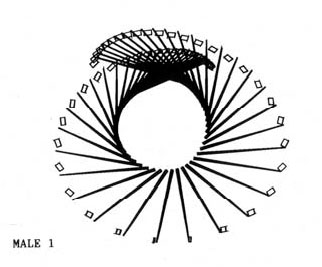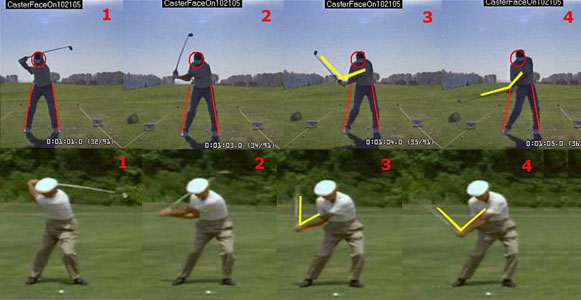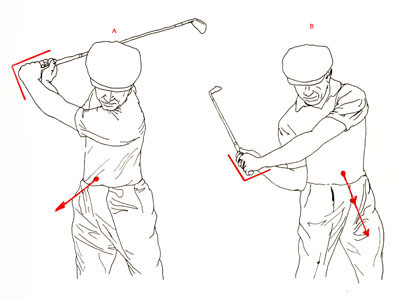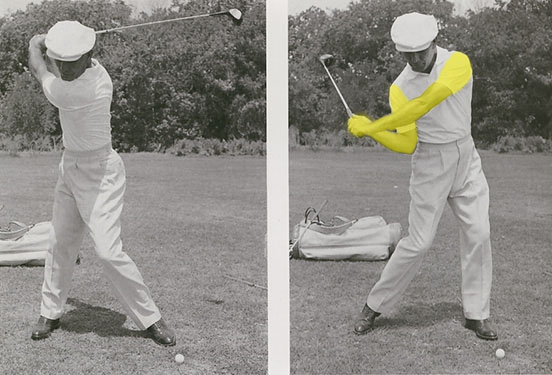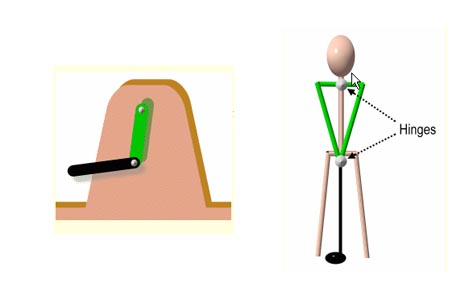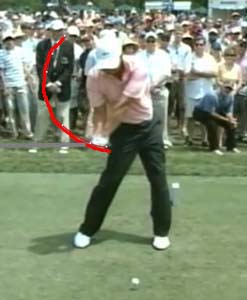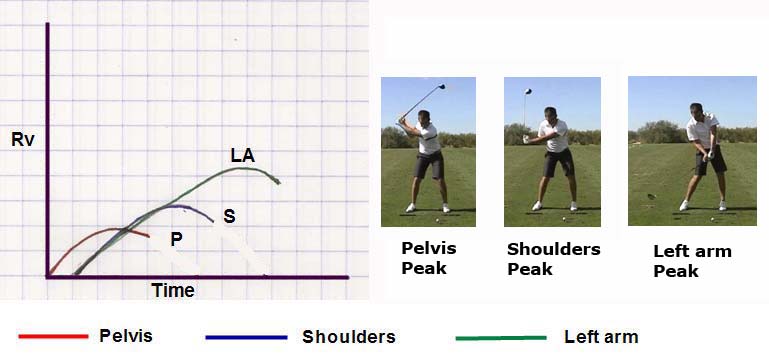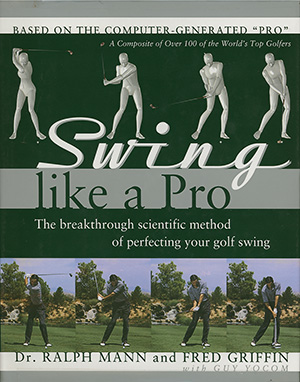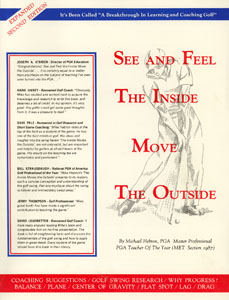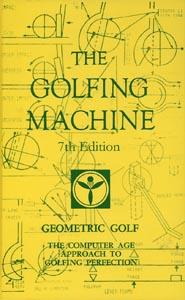How to Maximise Wrist Lag and Avoid Casting
Click here to go back to the index page.
In this short review paper, I will be discussing the important issue of how a golfer can maximise wrist lag during the downswing and how he can avoid casting.To start, let me define the term "lag". What does it mean when one states that a golfer is lagging his club during the downswing? "Lag" is the term used to describe the phenomenon where the clubhead is lagging behind the hands throughout the downswing. Consider the following schematic diagram depicting the movement of the hands and club during a full golf swing [1].
Clubshaft and clubhead movement during the downswing and followthrough
This diagram depicts the movement of the hands and club during the full golf swing of a low handicap golfer. The inner circle traces the movement of the hands/grip throughout the downswing/followthrough, the straight line represents the clubshaft and the rectangular box-end represents the clubhead. It can be seen that the hands lead the clubhead throughout the downswing, and that the clubhead only passes the hands after impact (after ~ 6 o'clock position). At impact, the clubshaft should have slight forward shaft lean as the hands should be slightly ahead of the clubhead at impact. A good golfer will ensure that he lags the club throughout the entire downswing and he will never let the clubhead flip past the hands before impact. This explanation should give a beginner golfer an understanding of what is meant by the term "lag" from a qualitative perspective. However, a beginner golfer should also appreciate that lag has a quantitative aspect. From a quantitative perspective, one should assess the amount/degree that the clubhead lags behind the hands at different time points in the downswing. If one looks at the above diagram, one can discern that the degree of lag is greatest at the start of the downswing, that it lessens slightly during the mid-phase of the downswing, and that it lessens markedly during the late phase of the downswing. The term "release" is commonly used to describe the marked decrease in the degree of lag that occurs in the late downswing (when the clubhead starts to catch-up to the hands), and I will also be discussing the release phenomenon in this paper.What is meant by the term "maximising wrist lag"? Maximising wrist lag refers to the situation where the golfer attempts to retain the greatest degree of lag for the longest period of time during the early/mid downswing. Consider the magnitude of Ben Hogan's downswing wrist lag.
Ben Hogan's wrist lag during the downswing
The lag angle (also called the release angle) is the angle between the clubshaft and the left forearm and it is a measure of the magnitude of wrist lag. In image 1 (end-backswing position), one can see that Ben Hogan had very flexible wrists that enabled him to establish a large degree of lag at the beginning of the downswing - his lag angle is <90 degrees. Most amateur golfers will not be able to achieve a magnitude of lag that large, and they should attempt to achieve a lag angle of at least 90 degrees at the end-backswing position. The narrower the lag angle at the beginning of the downswing, the more lag that a golfer will have at any measuring point during the downswing. Most importantly, a good golfer often has the capacity to retain that 90 degree lag angle for a long period during the early-mid downswing. Note that Ben Hogan has the amazing ability to retain a 90 degree lag until very late in the mid-downswing - until his hands are well below waist level (image 4). The term "maximising wrist lag" refers to the situation whereby a golfer attempts to maintain the maximum amount of wrist lag in the early/mid downswing - from image 1 to image 4 in the above sequence - because maximising wrist lag maximizes clubhead speed at impact.
Most amateur golfers cannot retain their maximum degree of attainable lag in the early/mid downswing, and they start to lose their maximum degree of attainable lag relatively early in the downswing. Consider a comparison between an amateur golfer's swing and Ben Hogan's swing.
Comparison of the degree of lag between ClubCaster (amateur golfer) and Ben Hogan.
ClubCaster is the chosen internet-name that an amateur golfer (who is fascinated by the subject of "what causes casting") uses at his personal website [2]. Casting in the term used to describe the phenomenon whereby the maximum degree of lag angle is lost in the early downswing - as if the golfer is intentionally, or unintentionally, casting the club like a flyfisherman casting his fishpole when flyfishing. Clubhead throwaway is another term that is used to describe the phenomenon of casting.Clubcaster is so interested in the cause of casting (clubhead throwaway) that he established a website to study the subject (called "ClubCaster's Golf Swing Improvement Site" dedicated to finding a cure for casting [2]), and he periodically updates his website by plotting changes in his degree of casting with the passage of time. The top half of the above photo compares ClubCaster's downswing (from July 2006), at comparable points in the downswing, to Ben Hogan's downswing. Note that Clubcaster managed to obtain a 90 degree lag angle at the end-backswing, which is very appropriate for an amateur golfer. Note that ClubCaster starts to lose his maximum degree of lag angle very early in the downswing (image 3), and that he has lost his 90 degree lag angle by the time his hands reach below waist level (image 4) - while Ben Hogan can still retain a 90 degree angle at that same point in the downswing (image 4). What enables a good golfer, like Ben Hogan, to retain wrist lag and avoid casting? That's the subject-topic for the remainder of this paper.
How to maximise wrist lag and how to retain the maximum attainable wrist lag during the downswing
I have perused >30 golf instructional books, and many of them advise a golfer to maximise wrist lag and to also retain that wrist lag for the longest possible time during the downswing. Interestingly, and significantly, although the book authors uniformly make this recommendation, they generally do not explain how to achieve this goal. The phrase "retain wrist lag" or "maintain wrist lag" is commonly used, but how is that goal achieved. Some book authors imply that retaining wrist lag is an active phenomenon, but is that true? Does a golfer need to actively retain his maximum-attainable wrist lag by actively using his wrists in some fashion, or is the phenomenon of wrist lag a passive phenomenon that is primarily due to other factors? Insight into this problem is gained by examining the writings of book authors who seriously address this complex issue.In their book [3], the SLAP authors, who computer-analysed the swings of hundreds of professional golfers, stated the following with respect to lag-:
"The Magical Release Angle. A well-known yet somewhat sophisticated term in teaching circles is "retaining the release angle". This expression refers to the angle created by the left arm and the clubshaft during the downswing. It plays a critical role in your ability to generate clubhead speed and greater distance. The basic rule is this: the more acute the angle, and the longer you can retain the angle during the downswing, the further you will hit the ball. -------- Good mechanics is the only way to produce a model release angle. It must be allowed to happen, and no amount of effort or determination can force it to occur. ----- the angle narrows primarily because of the way the lower body and right side work as the move towards the target gets underway."
The SLAP authors do not elaborate further on this issue in their book, and they do not fully explore the causal connection between "how the lower body and right side works" and a golfer's ability to retain the release angle.
In his book [4], Mike Hebron states-:
"Retain the angle - retain the angle - some books and golf teachers will loudly suggest. During the front swing, they want golfers not to change the angle or position that the hands and wrists fall into at the top of the backswing until the impact area. In my view, when you do nothing consciously with the hands, arms and club in the front swing, this all important move of retaining the angle is automatically accomplished. It has to be. The only time the angle will break down is when the golfer tries to do something with the swing besides moving forward with the lower inside."
In other words, Mike Hebron is suggesting that a golfer doesn't hold the angle by some active wrist/hand manipulations, and he recommends that the golfer shouldn't do anything consciously with the hands/arms/club. The golfer should only move the lower inside forward. What does he mean by this statement? Consider the following diagram from his book.
The Inside Moves First - Mike Hebron [4]
In his book, Mike Hebron has the following statement accompanying the above diagram-: "When the hands and arms do nothing, and are moved by the inside, the ANGLE is retained". What is the inside? What he is basically saying is that the shift-rotation of the lower body to the left at the start of the downswing (which causes the lower-mid torso to shift-rotate around to the left), will move the hands down to waist level while retaining the wrist lag angle. How is the wrist lag retained during this movement of the lower body? Mike Hebron states that it will happen automatically, but I believe that it will only happen automatically if a golfer allows the left arm and right arm to move as a single unit so that the hands move in a straight line direction - in response to the movement of the lower torso. What represents a single unit? The following photograph will help explain that "single unit" concept.
Ben Hogan - adapted from reference number [5]
I have deliberately colored-in-yellow Hogan's left and right arm. Note how the right elbow is still bent at a right angle - as it was at the end-backswing position. As Ben Hogan rotates his lower body towards the target, the "straight left arm + bent right arm" act as a single unitary structure and they are both passively pulled down towards waist level as a single unit. Homer Kelley refers to this unitary structure of the left arm and bent right arm as the power package assembly [6]. In other words, Ben Hogan does nothing actively with his hands/arms/club during the early downswing - he simply allows them to respond reactively/passively to the shift-rotational movement of the lower body, and he simply allows the entire power package assembly to be passively pulled down to waist level. The following swing video will demonstrate Ben Hogan performing this downswing move in "real life".Ben Hogan's downswing initiating move - http://www.youtube.com/watch?v=QL_6M_xZvq0
When watching the video, pay strict attention to the distance between Ben Hogan's hands and right shoulder as he repeatedly performs the lower torso shift-rotational movement that initiates the downswing action - note that the distance beytween his hands-and-right shoulder remains constant during this maneuver. This fact is very important because it demonstrates that the right shoulder must be moving forward at the same rate of speed as the hands. This fact also proves that Ben Hogan is not moving his arms/hands independently away from his upper body during the early downswing. The arms/hands are passive and are moved downwards and forwards by the rotation of the torso - the lower-mid torso moves first, and the upper torso (shoulders) immediately follows.
A key element that also allows the power package to remain intact during the early downswing is the fact that the right upper arm is being actively adducted towards the right side of the torso, so that the right elbow is being actively driven towards its pitch location in front of the right hip. Note how Ben Hogan's right elbow leads the hands - it "appears" below the left arm in the above photo. That allows Ben Hogan to maintain a bent right elbow, which ensures that the right forearm flying wedge (colored in red in the next photo) maintains its ~90 degree relationship to the left arm flying wedge (colored in yellow in the next photo).
Ben Hogan "slotting" the club in the early downswing - capture images from his swing video [7]
During the early downswing, Ben Hogan keeps the power package intact when "slotting" his club - and a key factor that alllows him to achieve that goal is the fact that he maintains a bent right elbow by actively adducting his right upper arm (colored in green) towards the right side of his torso during the early downswing. That active right upper arm movement allows the right forearm flying wedge (colored in red) and right hand to travel at the same speed as the left hand - while the right wrist still remains bent-back (dorsiflexed). If Ben Hogan didn't actively drive his right elbow down towards his right hip area (by *actively adducting his right upper arm in the early downswing), and if the right elbow remained further back (floating in space behind the hands), then the right elbow would start to prematurely straighten in the early downswing. If the right elbow prematurely straightens, it would produce a push-force against PP#1 and the aft side of the grip (via PP#3) and it would likely cause the left wrist to prematurely uncock - thereby producing the unwanted phenomenon of casting (clubhead throwaway). Note that Hogan's right shoulder also moves downplane during the power package slotting phase (images 1 & 2 & 3) and that allows him to keep PA#4 loaded during the early downswing. If the right shoulder didn't move downplane when the right arm is adducted in the early downswing, then the right arm would prematurely straighten leading to a premature release of the club. A golfer should ingrain the "feel" that the right shoulder is moving at the same speed as the right elbow/RFFW in the early downswing.(* I have discussed this issue in even greater detail in a new review paper written in December 2009 - Book Review: The Slot Swing - Jim McLean)
Mike Hebron suggests that a golfer will automatically be able to retain the 90 degree lag angle if he doesn't do anything active with the hands in the early-mid downswing, and that passive hands allows the lag angle to be retained. However, he doesn't provide any further details regarding the physics/mechanics of this complicated phenomenon of retaining/releasing the lag angle.
To better understand the phenomenon of club release, a golfer first needs to understand the fundamental principle of the double pendulum swing model.
David Tutelman's explains the club release action in this review paper - http://www.tutelman.com/golf/design/swing1.php?ref=
David Tutelman uses the concept of a centrifugal force as causing the club release phenomenon.
Double pendulum swing model
The double pendulum swing model consists of two arms - the central arm and the peripheral arm. There is a passive hinge joint between the central arm and the peripheral arm (equivalent to the left wrist in a left arm swing action). The only force applied to the double pendulum swing model system is at the central hinge point - a central torque generator causes the central arm to swing in a circular arc because it is suspended from the central hinge point. As the central arm swings in a circular arc, the peripheral hinge point (at the end of the central arm) also moves in a circular arc, and the peripheral arm (equivalent to the clubshaft) is passively pulled along by its attachment at the peripheral hinge joint. The only force that the peripheral arm (clubshaft) experiences is indirect - it simply responds passively to the pulling motion exerted at the peripheral hinge point, which is moving in a circular arc due to the fact that the central arm is moving in a circular arc. At every moment in time the peripheral arm wants to move in a straight line direction (in response to the pulling force exerted by the peripheral hinge point), but because the peripheral hinge point is constantly moving in a circular direction (= a straight line direction that is constantly changing its direction in a circular fashion), a centrifugal force develops that causes the club to release. That centrifugal force causes the peripheral arm (club) to passively release so that the peripheral arm (clubshaft) becomes straight in-line with the central arm (left arm) by the low point of the circular swingarc.
In other words, the club releases due to the fact that the peripheral hinge point (equivalent to the left wrist) moves in a circular arc.
I demonstrate this club release phenomenon using a simple, home-made double pendulum swing model in the following short swing video demonstration.
http://www.youtube.com/watch?v=fBu30VbvBRY
In this swing video demonstration of a double pendulum swing model system, I demonstrate that the club only releases when the peripheral hinge point (equivalent to the left wrist) moves in a circular direction and I demonstrate that the club wouldn't tend to release if the peripheral hinge point moves in a straight line direction eg. directed straight downwards (along the inclined plane) in the direction of the ground.
If you understand that point, then you should be able to understand why Hogan's club doesn't release in the early downswing.
Consider the following series of capture images from Hogan's swing video lesson.
Hogan's hand arc path - capture images derived from his swing video lesson
I used a spline tool to trace Hogan's hand movements during his downswing (white dots and connecting red lines).Images 1 and 3 show Hogan's hand arc movement in the early downswing - when the entire power package assembly is being passively pulled down to waist level secondary to the pelvis shift-rotation movement that initiates his downswing action. Note that the hand arc path is relatively "straightish" in the early downswing and that it is mainly directed in a straight line direction towards the ground (yellow arrow in image 3). In a sense, you can imagine that Hogan's hands are pulling the grip end of the club in a straight line direction down the inclined plane and that the direction of the straight line pull is roughly along the longitudinal axis of the clubshaft. As I demonstrated in my double pendulum swing model video lesson, the club will not passively release when the left wrist/hand (that pulls the passive clubshaft) travels in a straight line direction.
Images 2 and 4 shows Hogan's hand arc path during the mid-downswing. Note that the hand arc path changes direction quite abruptly in the mid-dowswing, and that it acquires a tight (small radius) circular arced motion as the hands suddenly move more forward in the direction of the target. What causes the sudden change in direction of the hand arc path at this time point in the downswing? The "correct" answer is that Hogan is releasing power accumulator #4 at this time point in his downswing. Power accumulator #4 is released when the pivot action subsides in the mid-downswing, and that causes the left arm to be blasted/catapulted away from the chest wall - note the steadily increasing distance between the hands and the right shoulder in images 2 and 4.
Here is a swing video demonstration of Hogan's release of power accumulator #4.
http://www.youtube.com/watch?v=CWbppUcInrs
When Hogan releases power accumulator #4, it causes the left arm to freewheel away from the chest wall. Because the left arm is attached to the body at the left shoulder socket joint, which is the fulcrum point for the left arm's swinging motion, the left arm will swing freely in a circular arced manner during the release of power accumulator #4. That circular left arm motion causes the left wrist/hand (equivalent to the peripheral hinge point in a double pendulum swing model) to transcribe a circular motion in space, and that causes the club to release. You can clearly see Hogan's club releasing in images 2 and 4.
The *speed of club release depends on two factors - i) the radius of the circular hand arc path and ii) the speed of left arm/hand movement during that moment-in-time. The smaller the radius of the circular hand arc path (the tighter the hand arc curve) the faster the club will release, and the faster the hands are traveling at that moment-in-time the faster the club will release.
(* See nmgolfer's mathematical explanation regarding the release phenomenon - http://perfectgolfswingreview.net/New%20Millennium%20Golf%20Science.htm - where he shows how the club acquires angular acceleration when the hand pull direction is at angle to the clubshaft. A major advantage of his mathematical explanation is that it allows a golfer to understand the release phenomenon without having to use a vague term like "centrifugal" - a term which many people understand differently)
Hogan has a late release because he has a tight hand arc curve at the bottom of his U-shaped hand arc path and there is a very abrupt transition between the straightish section of his U-shaped hand arc path and the circular section of his U-shaped hand arc path (an abrupt change in direction of his hand arc path in mid-downswing).
If the hand arc path is more circular, and less U-shaped, then the club will release sooner in the downswing and the speed of release will be more gradual - as can be seen in Anthony Kim's driver swing.
Anthony Kim swing video - http://www.youtube.com/watch?v=oqmejmw-lu4&NR=1
Anthony Kim hand arc - capture image from his swing video
Note that Anthony Kim's hand arc is more rounded than Hogan's hand arc and there isn't an abrupt directional-turn at the bottom of his U-shaped hand arc. The end-result is that Anthony Kim's club starts to release earlier in the downswing and the release is more gradual (because the hand speed in the early downswing is less fast than it is in the mid-downswing after the release of PA#4). You can see his timing and speed of club release in his slow-mo swing video.Many amateur golfers, like ClubCaster, release their club at the very start of the downswing action, or very soon after the start of the downswing action, and the club releases gradually and progressively throughout the downswing. This is called a sweep release, in contrast to Hogan's late release and Anthony Kim's random release (defined as any release pattern that is intermediate between a sweep release and a late release) [6]. There are two factors that act synergistically to produce a sweep release - i) over-acceleration of the club at the start of the downswing due to pulling the club very assertively down towards the ball with the hands at the very start of the downswing (associated with a premature straightening of the right elbow) and ii) swinging the hands in a circular arc (rather than an U-shaped arc) due to the fact that the left arm is pulled away from the torso at the very start of the downswing (out-of-order kinetic sequence). In other words, if a golfer starts the downswing by swinging the left arm down from the left shoulder socket while keeping the left shoulder socket near-stationary, then the hand arc will be circular in shape and the release pattern will likely be a sweep release pattern.
If a beginner golfer wants to acquire a random/late release pattern, then he needs to modify the start of his downswing by i) avoiding any active independent movement of the left arm/hands and by ii) avoiding any over-acceleration of the hands in a circular arc in the early downswing and by iii) avoiding any premature straightening of the right elbow joint. He must start the downswing's kinetic sequence correctly with a lower body move, that passively pulls the intact power package down to waist level.
Kinetic sequence of a good golfer
Rv = Angular velocity. Note the kinetic sequence in a good golfer's swing eg. a professional golfer like Aaron Baddeley. The kinetic sequence starts with a lower body movement, followed immediately by an upper body movement, that passively pulls the club down in a straight line direction towards the ground - see the small inserted images 1 & 2 of Aaron Baddeley. During this phase of the swing, the hands are not moving very fast. The combination of a "straightish" hand arc and a relatively slow hand speed doesn't induce club release. Note that the left arm (and therefore hand) speed reaches its maximum speed in the mid-late downswing when the hands are also moving in a circular fashion due to the release of PA#4 - see third inserted image of Aaron Baddeley, which shows the i) widening distance between his hands and right shoulder due to the release of PA#4 and ii) his club secondarily releasing due to a centrifugal action.Each individual golfer, who has an optimised kinetic sequence, will have a slightly different random (or late) release pattern that varies depending on the timing of the kinetic sequence (individual variations in the timing and speed of release of PA#4 relative to the timing of the lower body, and then upper body, rotational movements). An important point is that a golfer must never attempt to "hold onto the left wrist angle" by artificially stiffening the left/right wrists - in an attempt to delay the release point. The wrists must always be very relaxed during the entire downswing.
Another method of mentally understanding the physics/mechanics of the "club release phenomenon" has been proposed by Homer Kelley in his TGM book [6]. He writes about the "endless belt" concept. I have written a new review paper called "Understanding the Club Release Phenomenon - The Endless Belt Concept" and it discusses this complex subject of maintaining/maximising lag in even greater depth. Golfers who want to better understand the physical/mechanical factors involved in the "club release phenomenon" should also read that new review paper.
Addendum added June 2010:
Golfers often seek a drill to help them practice the "feel" of maintaining lag and avoiding casting. The only drill that I would recommend is called the "pump-it" drill, or the "pump-pump-and-release" drill.
Here are three golf instructors demonstrating the "pump-it" drill.
http://www.youtube.com/watch?v=QBzw2FvyJvE
http://www.youtube.com/watch?v=KD24wk2jf4I
http://www.youtube.com/watch?v=A9Pe7oXe23cThe different golf instructors describe the action differently and emphasize different points. The important goal is to ensure that the power package remains intact (left arm/clubshaft flying wedge alignment remains at a ~90 degree angle; right forearm remains at a ~90 degree angle to the left arm flying wedge; and right elbow maintains its ~90 degree bend) during the "pump-it" action. To achieve that goal, a golfer must "feel" that the "inside-moves-the-outside" when the downswing starts with a pelvic-shift rotation motion, and simultaneously "feel" that the right arm is being actively adducted towards the right side of the torso, so that the right elbow gets actively pulled down to its pitch location in front of the right hip area. When performing the drill, make sure that the right elbow's right-angle bend is maintained, and that there is no premature straightening of the right elbow during the "pump-it" motion. For that biomechanical phenomenon to happen, the right elbow must be moving down (as a result of the active right upper arm aduuction motion) at the same speed as the left arm is being pulled down by the "inside-moves-the-outside" action.
Jeff Mann.
First draft version: 2007.
Revised version: 2009.
References:
1. Steven Nesbit. A three dimensional kinematic and kinetic study of the golf swing. Journal of Science and Sports Medicine. Vol. 4 Issue 4. Page 499-519.http://www.jssm.org/vol4/n4/17/v4n4-17text.php
2. ClubCaster's Golf Swing Improvement Site.http://clubcaster.home.comcast.net/index.html
3. Swing Like a Pro. Ralph Mann and Fred Griffin.
4. See And Feel The Inside Move The Outside. Mike Hebron.
5. The Fundamentals of Hogan, David Leadbetter.
6. The Golfing Machine. Homer Kelley.
7. Ben Hogan swing video segment
http://www.youtube.com/watch?v=LJdChWnxDvU
